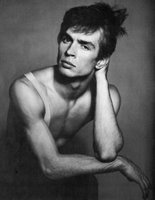 Rudolph Nureyev born 17 March 1938 (d. 1983)
Rudolph Nureyev born 17 March 1938 (d. 1983)Rudolph Nureyev was the greatest male ballet dancer of his generation - and one of the two most significant of the 20th Century - the other being Nijinsky.
Born on a train somewhere in Siberia in 1938, he was a small, sensitive, somewhat deprived boy, bullied and tormented by the other children. But he had a flair for folk-dancing, and was discovered, taught and encouraged by two exiled ballerinas living in Ufa. His father was less than pleased on his return from the Second World War to discover his son studying ballet - picture a Russian Billy Elliot. His natural ability and an unshakeable self-belief gave him his escape.
Aged 17, he found himself enrolled at the Leningrad Ballet School, where he was brilliant and difficult. In 1958, following graduation he became a soloist with the Kirov Ballet. Having always struggled with the confining rules of the Soviet way of life, he fell foul of the Soviet security regulations while on tour with the Kirov Ballet in Paris in 1961, and rather than be sent back to the USSR, slipped his minders at the airport in Paris and sought political asylum in France - his 'great leap to freedom'.
 Tried and convicted of treason in his absence, he spent the rest of his life fearing kidnap or assassination, for his defection had made headlines around the world and a superstar of the young Nureyev. His family, friends and teachers back home paid the price for his freedom.
Tried and convicted of treason in his absence, he spent the rest of his life fearing kidnap or assassination, for his defection had made headlines around the world and a superstar of the young Nureyev. His family, friends and teachers back home paid the price for his freedom.His physical beauty, extraordinarily athletic and sexual dance persona, and bags of Russian charm, made him a leading light in the glittering world of international cafe society. But his passport to lasting success was the way he transformed the role of the male ballet dancer, much as Nijinsky had done years before - the solo male again became electric and thrilling.
He became a soloist with the London Royal Ballet, the Chicago Opera Ballet and the Paris Opera Ballet, as well as forming his own touring companies and achieving great success as an artistic director and choreographer - particularly re-energising the established classics such as Giselle, Swan Lake, The Nutcracker and Romeo & Juliet.
 His partnership with Margot Fonteyn [pictured] made both their stars burn brighter. His dancing career was long and he toured the world extensively, raising the profile of ballet and his own central role as its most shining star.
His partnership with Margot Fonteyn [pictured] made both their stars burn brighter. His dancing career was long and he toured the world extensively, raising the profile of ballet and his own central role as its most shining star.Nureyev's other significance was his openness about his own sexuality - ballet was ironically very closeted because of its effeminate image. Because he made no effort to appear heterosexual and yet was an incredibly athletic and male performer, he was able to explore and express roles without restrictions, which gave a depth not only to his performances but to the range of artistic expression for other male dancers. This openness however, may have had much to do with his extreme arrogance and super-sized ego.
 Famously well-endowed, his sexual life was the stuff of legend - the gay playboy of the western world. But he also enjoyed several long-term relationships - he spent the early 60s involved with an older Danish dancer named Eric Bruhn (1928-1986) but their relationship had suffered from something of a 'Star Is Born' nature as Nureyev's career rocketed and Bruhn became an alcoholic. In the 1970s, he had a long relationship with Wallace Potts, a director and archivist; and in 1978 he met a young dancer named Robert Tracy, who moved into his New York apartment and stayed for fourteen years until he was evicted, complaining that he had been treated `like a lackey'.
Famously well-endowed, his sexual life was the stuff of legend - the gay playboy of the western world. But he also enjoyed several long-term relationships - he spent the early 60s involved with an older Danish dancer named Eric Bruhn (1928-1986) but their relationship had suffered from something of a 'Star Is Born' nature as Nureyev's career rocketed and Bruhn became an alcoholic. In the 1970s, he had a long relationship with Wallace Potts, a director and archivist; and in 1978 he met a young dancer named Robert Tracy, who moved into his New York apartment and stayed for fourteen years until he was evicted, complaining that he had been treated `like a lackey'.In 1983, Nureyev was diagnosed with HIV. Rudolph Nureyev died of an Aids-related illness in Paris in April, 1993.
Leaving nothing to Robert Tracy (who took legal action and won), he left the bulk of his fortune to establish foundations to promote dance and medical research.
Rudolph Nureyev Foundation
Rudolph Nureyev - The Life
Top Photo of Rudolph Nureyev and nude photo by Richard Avedon. Second photo: RUDOLPH NUREYEV, ROYAL BALLET SCHOOL, LONDON, 1963 by SNOWDON